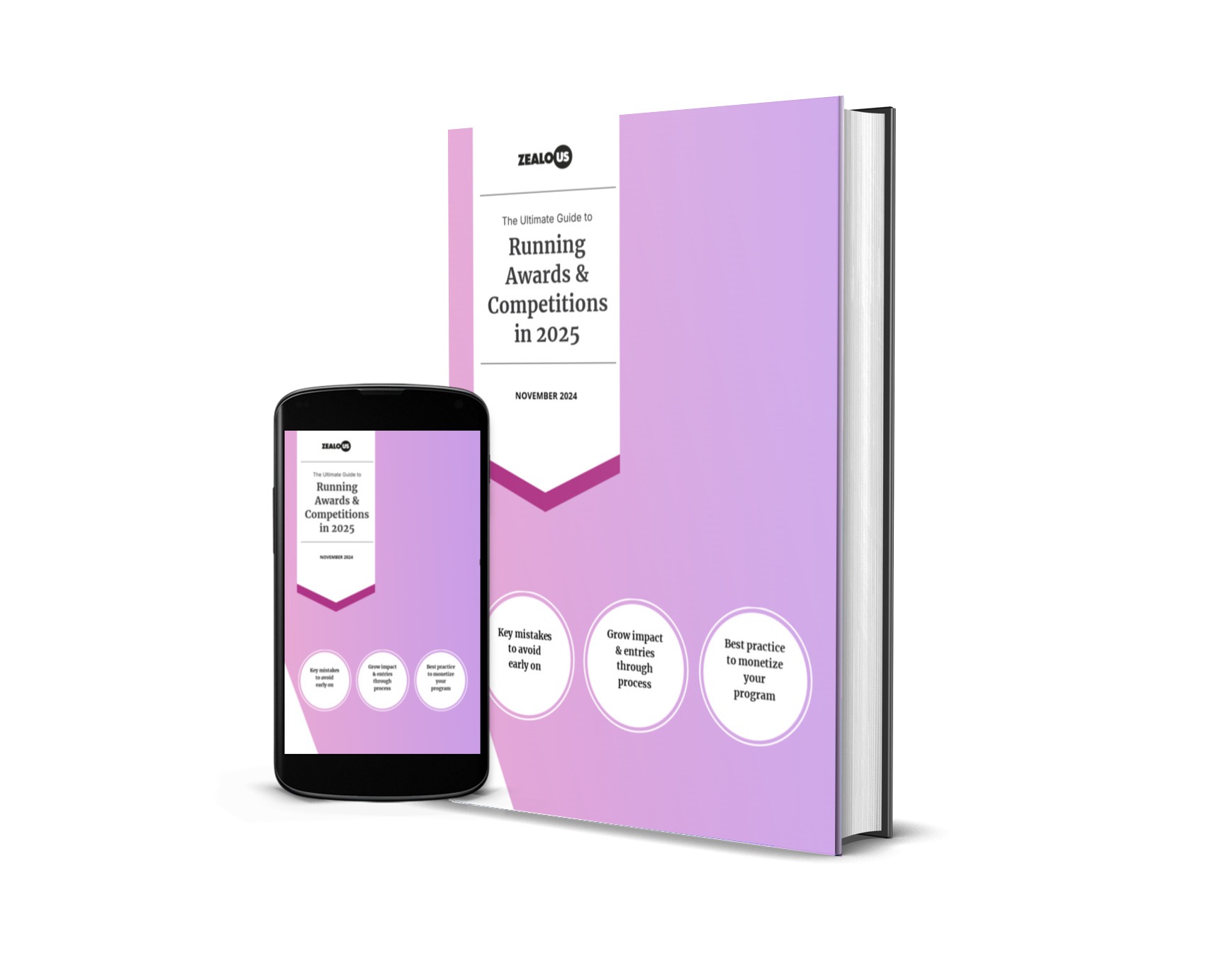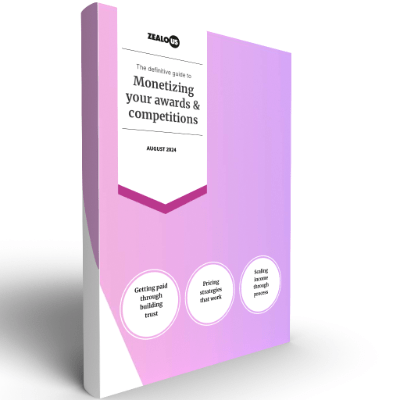This article covers:
- Think of guidelines as a conversation, not a contract
- Master your short pitch
- Write for everyone (yes, everyone)
- Consider alternatives to written guidelines
- Length matters (shorter wins)
- Make formatting work for you
- Context is everything (remove duplication)
- Test everything before you launch
- Platform capabilities matter more than you think
- Remember: perfection doesn’t exist
Nobody reads instruction manuals (I know I don’t!). Yet competitions depend on candidates reading guidelines. It’s almost feels like a catch-22.
Although it is tricky, it is possible a balance between being comprehensive whilst engaging.
The guidelines you craft will directly impact the quality and quantity of submissions you receive. Too vague and you’ll field hundreds of confused emails three days before your deadline (usually on a Friday at 5pm). Too detailed and potential candidates will take one look at the wall of text and quietly close the tab.
Key insight
Writing good guidelines from scratch is hard. You can never really know where your candidates are going to stumble. The good news is that nothing stops you from improving them as you go, even whilst submissions are open.
Think of your guidelines as a conversation (not a technical manual)
When did you last read an appliance manual cover to cover? If the answer isn’t “never,” you’re a better person than I!
Manuals dump information on you without considering the reader’s journey. Your guidelines shouldn’t be like that.
Start by anticipating the questions candidates will ask, and in what order they’ll ask them. Someone discovering your competition for the first time will wonder: “Is this for me?” before they care about file formats or submission deadlines.
Walk them through your opportunity the way you’d explain it to a friend. Begin with a compelling pitch that makes them want to know more. Then confirm eligibility early. Nobody wants to invest 20 minutes reading guidelines only to discover they’re not eligible.
Build your guidelines following the structure below. It mirrors how people naturally process information about new opportunities.
Why (motivation)
- Short pitch of what you’re offering
- Who can participate
- Why they should submit
How (process)
- Costs (if any)
- Timeline and key dates (getting your schedule right)
- What you need them to submit (streamlining your ask matters)
- How you’ll select winners (planning your selection criteria)
- FAQ (if needed)
- How to actually submit
What (context)
- Who you are as an organisation
- Supporting materials and terms
This structure respects your candidates’ time and meets them where they are in their decision-making journey.
Master your short pitch
Your short pitch deserves serious attention. It’s the hook that determines whether someone reads on or moves on.
Keep it to one paragraph maximum. Imagine you’ve got 20 seconds to explain your competition to someone in a lift. What would you say?
Aim to cover three or four critical elements:
- What type of opportunity (award, competition, residency, commission)
- Location or scope (global, UK-based, London-specific)
- Who it’s for (emerging photographers, writers, digital artists)
- The main prize or benefit (funding, exhibition, mentorship, industry recognition)
Here’s how this could look in practice:
Our annual awards celebrate the UK’s top emerging creative talent across all disciplines, with £12,000 in prizes and exhibitions at leading galleries.
Win a £100,000 grant aimed at UK-based arts organisations who’ve demonstrated creativity in supporting their communities.
Secure an artist residency in Lagos (Nigeria) founded by Yinka Shonibare, with studio space, materials budget, and exhibition opportunities.
Notice how each example immediately clarifies who should apply and what they stand to gain. No fluff.
If your competition features judges or supporters worth highlighting, mention them. Having someone’s work reviewed by a respected figure in their field can be just as compelling as prize money.
Download launch checklist
Never miss a critical step: 300+ tasks across 8 phases, from securing judges to winner announcement.
Write for everyone (yes, everyone)
Complex language doesn’t make you sound professional. It makes you sound inaccessible.
When you write your guidelines, assume your reader knows nothing about your competition. Avoid jargon. Skip assumed knowledge. Keep sentences short and clear.
This isn’t about dumbing things down. It’s about opening things up.
People who’ve learned English as a second language deserve the same shot as native speakers. The same goes for candidates who process information differently or those using screen readers to navigate your content.
Simple, direct language helps everyone. That’s not a nice-to-have; it’s essential if you want to reach the diverse range of creative talent that exists beyond traditional networks. This is part of building genuine inclusivity into every stage of your competition.
Consider alternatives to written guidelines
Some people absorb information better through video than text. Others prefer audio. A few might benefit from both formats alongside written guidelines.
Providing multiple ways to engage with your content isn’t about ticking accessibility boxes. It’s about genuinely reaching more people.
A short video (three to five minutes) walking through your key requirements can clarify things faster than paragraphs of text. You don’t need a production budget – but clear audio is a must (decent lighting helps).
For candidates with dyslexia, visual processing challenges, or those who simply prefer hearing information explained, alternative formats remove a genuine barrier to entry. Modern platforms should support multiple content types without making life harder for administrators.
Accessibility tip
If you wish to serve a community with specific needs, try and involve them early to test your process before you open submissions. For example, if you want to engage with blind writers, get someone with a screen reader to apply once you’re ready (and be sure to reward them for their time).
Shorter is better
Long guidelines feel intimidating. Even well-written ones.
You might think clarity requires length, but the opposite is true. Research shows that candidates are significantly less likely to complete forms when faced with extensive text blocks, regardless of how “clear” the information is.
Once you’ve drafted your guidelines, review them ruthlessly. Remove any sentence that doesn’t serve a specific purpose. Cut redundancy. Trim examples that don’t add value. AI is great at trimming things back, just be sure to review the changes to ensure nothing vital was trimmed (or worst “hallucinated” – there’s nothing worst than finding out you’ve promised to give everyone on the shortlist mashmallows…)
Every word you remove lowers the barrier to entry.
Quick calculation
Let’s say you receive 300 submissions. If your guidelines save each candidate just five minutes of reading time, you’ve collectively unlocked 25 hours of creative work. That’s nearly a full week someone could spend making better work instead of deciphering requirements.
Plus, tighter guidelines mean fewer confused enquiries landing in your inbox when you’re trying to focus on other things.
Want more articles like this?
Give this one a like
Make formatting work for you
Walls of text kill engagement. Even if your content is brilliant, poor formatting will lose people.
Your guidelines need clear visual hierarchy. Break content into scannable sections with descriptive headings (like this article). Use short paragraphs (two to four lines maximum). Highlight key information sparingly with bold text.
Bullet points help when listing multiple items (like this), but don’t overuse them. Some candidates process lists better than prose, while others prefer the opposite.
Formatting best practices:
- Separate main sections with clear, large headings
- Use smaller headers for subsections
- Keep body text consistent in size and style
- Limit paragraphs to 4-5 lines
- Bold important details (use sparingly)
- Use bullet points for lists, not as a crutch
- Link to supporting materials rather than copying everything into guidelines
Good formatting particularly helps candidates with dyslexia, ADHD, or visual processing challenges. Spacing out content with clear structure makes information easier to parse and reference during the application process.
Context is everything (remove duplication)
Tools like GPT models, Word and Grammarly are brilliant for catching typos. But when you paste your guidelines into your submissions platform, check for duplicates. The information is contextual and might repeat elements already on your submissions management platform.
If your platform already displays submission deadlines, don’t repeat them in your guidelines. Should you extend your deadline (which happens), contradictory dates will create (lots of) confusion.
Candidates will assume the platform information is outdated if it conflicts with your written guidelines. Or vice versa. Either way, you’ll get emails asking which date is correct.
The same principle applies to terminology. If your submission button says “Submit,” don’t refer to it as “Apply” in your guidelines. These tiny inconsistencies cause friction.
Your website guidelines and platform guidelines will naturally differ – one is the full picture, the other is context-specific. That’s fine. Just make sure language and key details align where they overlap.
Test everything before you launch
Your guidelines made perfect sense when you wrote them. Six months from now, reading them fresh, you might spot three immediate improvements.
Give yourself that distance before launch. Write your first draft, then leave it for a day or two. Return and read it as though you’re seeing it for the first time. You’ll catch ambiguities you missed initially.
Better still, ask someone outside your organisation to complete a test submission. Fresh eyes catch issues you’ve become blind to.
Watch where they pause. Note which questions they ask. These insights will help you refine guidelines before hundreds of real candidates encounter the same problems. Testing helps you avoid common mistakes that derail even well-planned competitions.
Testing best practice
If your competition serves a specific community with particular needs – say, writers who use screen readers – involve someone from that community in testing. Compensate them properly for their time. You’ll learn infinitely more than you would from guessing what might work.
Insights like these straight to your inbox
Receive weekly tips from our founder to grow your program’s impact; regardless of what tools you use.
Enable easy contact throughout
Even perfect guidelines won’t answer every question. Someone will always need clarification.
Make it simple for candidates to reach you. Provide an email address. Add a contact form. If you’ve got capacity, offer live chat (many modern submission platforms include this).
Quick responses to simple questions build the trust that converts interest into submissions. They also reveal patterns. If you’re getting the same question repeatedly, check your guideline to see if that’s where the problem lies (is what is being said correct? Is something missing?)
Add an FAQ section (strategically)
FAQs catch repeat questions before they land in your inbox. But don’t create FAQs until you know what candidates actually ask.
If you’ve run similar competitions before, you’ll already know the common queries:
- Eligibility edge cases
- File format questions
- Payment or pricing clarifications
- What happens after submission
If this is your first competition, wait until submissions open. Track the questions you receive in the first few days. Add the most common ones to your FAQ section. This evolves your guidelines in real-time and prevents the same questions from multiplying as the rush to the deadline approaches. Tracking which questions recur most also gives you valuable metrics for understanding your candidate journey.
Each FAQ answer should be complete but concise (60-80 words works well for most questions). Don’t just say “yes” or “no” – explain why briefly, so the answer feels helpful rather than dismissive.
Allow guidelines to evolve during submissions
Your guidelines don’t need to be perfect on day one. Nothing stops you improving them while submissions are open (so long as you don’t change key things, like dropping a 0 from your prize money…try not to do that!).
Check the first batch of entries carefully. Are candidates submitting what you expected? If not, adjust your guidelines to clarify requirements. Better to fix confusion early than sort through 200 incorrect submissions later.
If multiple people ask the same question, add it to your FAQ immediately. Future candidates will thank you (silently, by not emailing you).
One caveat: document significant changes that impact candidates who have already submitted and communicate them with them directly. This keeps things fair and maintains trust in your process.
Platform capabilities matter more than you think
Your guidelines exist within a submission system. That system can either support or undermine your carefully crafted instructions.
Modern platforms should allow candidates to save their work and come back to complete entries later. Auto-saving candidate progress is also valuable, preventing the frustration of losing 20 minutes of work to a browser crash. Some programs even allow for entries to be edited once submitted.
Unlimited file sizes prevent arbitrary restrictions on what candidates can submit. Fixed caps (especially low ones treated as “premium features”) signal a platform built around limitations rather than possibilities.
If you’re evaluating different systems, consider whether simple online forms will scale with your ambitions or if you need dedicated awards management software. You can also explore detailed platform comparisons to understand which systems make candidates’ lives easier versus which create unnecessary friction.
Perfection doesn’t exist
The title of this article is deliberately provocative. Your guidelines will never be perfect.
What works brilliantly for one competition might need adjustment for another. Audience needs change. Creative sectors evolve. Your own understanding deepens with experience.
Accepting this frees you from paralysis. You don’t need perfect guidelines. You need good guidelines that can get better.
Copying last year’s guidelines without question stores up problems. The context has likely changed. Your audience might have shifted. At minimum, dates definitely need updating (we’ve all seen competitions accidentally listing last year’s deadlines!).
Ask yourself critical questions each time:
- Who are we trying to reach this year?
- What worked or didn’t work last time?
- Where did confusion arise?
- What questions did we answer repeatedly?
Iterate based on evidence, not assumptions. Your guidelines will improve each round. If entries fall short of expectations, don’t panic – there are proven strategies to diagnose and fix the issue.
Finally
Guidelines form a critical bridge between your vision for a competition and the submissions you actually receive. Get them right and you’ll reduce your own workload while improving entry quality. Get them wrong and you’ll spend deadline week fielding panicked enquiries instead of focusing on selection.
The structure outlined here – starting with why before moving to how and what – mirrors how humans naturally process new opportunities. Use it as a foundation, then adapt based on your specific programme and audience.
Every hour you invest in clear, accessible guidelines pays back tenfold in reduced admin time and better submissions. The candidates who do submit will thank you with higher-quality entries because they understood exactly what you wanted.
And yes, that includes reducing last-minute email barrages on Friday evenings. Your future self will appreciate it.
Want to streamline how you manage submissions? Modern platforms can handle this while you focus on running a brilliant competition.
We can help
Zealous streamlines submissions
But we’re not alone in the space – here are 8 others you may wish to consider (even if we would prefer you choose us!).
Want us to write more content like this? Give it a like
Share

Guy Armitage is the founder of Zealous and author of “Everyone is Creative“. He is on a mission to amplify the world’s creative potential.
Frequently Asked Questions
Should I provide guidelines in multiple formats (text, video, PDF)
Yes, if you can manage it.
Providing guidelines in multiple formats significantly improves accessibility. A short 3-5 minute video walkthrough helps visual learners and candidates with dyslexia, while downloadable PDFs work for those who want to reference guidelines offline. Text-based web guidelines remain essential for screen readers and quick scanning. Modern platforms should support multiple formats without creating admin headaches – if yours makes this difficult, that’s a limitation worth noting when evaluating systems.
Be sure to put these options up-front so your candidates can pick the one that best matches their needs from the get go (and don’t forget to update them all if one of them changes!).
How detailed should my selection criteria be in guidelines?
Detailed enough that candidates understand what you value, but not so prescriptive that you box yourself in. List three to five key criteria (creativity, technical skill, community impact, originality) with brief explanations. Avoid numerical breakdowns or percentage weightings in public guidelines—those belong in judge briefings.
Transparency builds trust, but you need flexibility during deliberation. The goal is helping candidates submit appropriate work, not teaching them to game a scoring system.
What if candidates keep asking the same questions despite clear guidelines?
This signals a disconnect between what you think is clear and what candidates actually understand. Add those repeat questions to an FAQ section immediately. Then review the relevant guideline section—it might need restructuring or simpler language.
Sometimes information is present but buried. Other times, candidates skip reading entirely and go straight to questions. Both scenarios require different solutions. Track which questions recur most and prioritise fixing those.
How long should competition guidelines be?
Long enough to prevent confusion, short enough that people actually read them. For most competitions, 800-1,200 words covers everything candidates need without overwhelming them. Break this into 10-12 sections with clear headings.
If your guidelines exceed 2,000 words, you’re probably including information that belongs elsewhere (detailed T&Cs, extended eligibility criteria, background about your organisation). Link to supporting documents rather than embedding everything in one place.
Do video guidelines really make a difference?
Yes, particularly for candidates who process information better audibly or visually. A three-to-five minute walkthrough explaining key requirements reaches people who might abandon lengthy written guidelines. You don’t need professional production—clear audio and decent lighting suffice.
Videos work especially well for complex submission processes or when demonstrating format requirements. Consider them complementary to written guidelines, not a replacement. Some candidates want text they can reference; others prefer watching someone explain.
Should guidelines mention all eligibility criteria upfront?
Absolutely. Leading with eligibility prevents candidates from investing time in an application they can’t submit. Put basic criteria (location, age, professional status) within the first 100 words. Nothing frustrates applicants more than discovering 20 minutes into an application that they’re ineligible.
Early disclosure respects everyone’s time and actually increases submission quality by filtering appropriately. If you need help defining who should apply, start with your competition’s core purpose.
How often should I update guidelines during an open submission period?
Only when genuinely necessary to prevent confusion or correct errors. Small clarifications in FAQ sections can happen any time. Substantive changes to requirements need clear communication to candidates who’ve already submitted.
If the first week of submissions reveals a major ambiguity, fix it immediately and notify existing applicants. Document all changes with dates so you can address fairness questions if they arise. Well-tested guidelines shouldn’t need major mid-competition rewrites, but don’t let perfectionism prevent helpful improvements.









